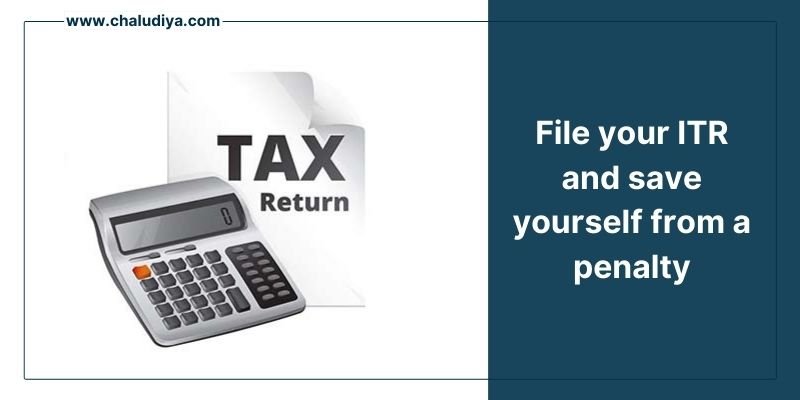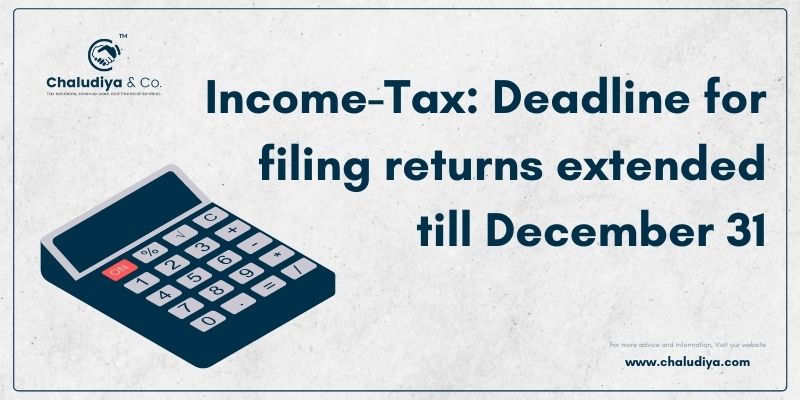- Have any questions?
- +91 76983 15026
- info@chaludiya.com
Income From House Property

File your ITR and save yourself from a penalty.
October 8, 2020
Income Tax Returns Filing Deadline Extended
October 24, 2020Basics of House Property
A house property could be your home, an office, a shop, a building or some land attached to the building like a parking lot. The Income Tax Act does not differentiate between a commercial and residential property. All types of properties are taxed under the head ‘income from house property’ in the income tax return. An owner for the purpose of income tax is its legal owner, someone who can exercise the rights of the owner in his own right and not on someone else’s behalf.
When a property is used for the purpose of business or profession or for carrying out freelancing work – it is taxed under the ‘income from business and profession’ head. Expenses on its repair and maintenance are allowed as business expenditure.
Self-Occupied House Property
A self-occupied house property is used for one’s own residential purposes. This may be occupied by the taxpayer’s family – parents and/or spouse and children. A vacant house property is considered as self-occupied for the purpose of Income Tax.
Prior to FY 2019-20, if more than one self-occupied house property is owned by the taxpayer, only one is considered and treated as a self-occupied property and the remaining are assumed to be let out. The choice of which property to choose as self-occupied is up to the taxpayer.
For the FY 2019-20 and onwards, the benefit of considering the houses as self-occupied has been extended to 2 houses. Now, a homeowner can claim his 2 properties as self-occupied and remaining house as let out for Income tax purposes.
Let Out House Property
A house property which is rented for the whole or a part of the year is considered a let out house property for income tax purposes
Inherited Property
An inherited property i.e. one bequeathed from parents, grandparents etc again, can either be a self occupied one or a let out one based on its usage as discussed above.
Steps to Calculate Income From House Property
Here is how you compute your income from a house property:
Determine Gross Annual Value (GAV) of the property: The gross annual value of a self-occupied house is zero. For a let out property, it is the rent collected for a house on rent.
Reduce Property Tax: Property tax, when paid, is allowed as a deduction from GAV of property.
Determine Net Annual Value(NAV) : Net Annual Value = Gross Annual Value – Property Tax
Reduce 30% of NAV towards standard deduction: 30% on NAV is allowed as a deduction from the NAV under Section 24 of the Income Tax Act. No other expenses such as painting and repairs can be claimed as tax relief beyond the 30% cap under this section.
Reduce home loan interest: Deduction under Section 24 is also available for interest paid during the year on housing loan availed.
Determine Income from house property: The resulting value is your income from house property. This is taxed at the slab rate applicable to you.
Loss from house property: When you own a self occupied house, since its GAV is Nil, claiming the deduction on home loan interest will result in a loss from house property. This loss can be adjusted against income from other heads.
Note: When a property is let out, its gross annual value is the rental value of the property. The rental value must be higher than or equal to the reasonable rent of the property determined by the municipality.
Tax Deduction on Home Loans
Tax Deduction on Home Loan Interest: Section 24
Homeowners can claim a deduction of up to Rs 2 lakh on their home loan interest, if the owner or his family resides in the house property. The same treatment applies when the house is vacant. If you have rented out the property, the entire home loan interest is allowed as a deduction.
However, your deduction on interest is limited to Rs. 30,000 instead of Rs 2 lakhs if both the following conditions stand satisfied:
a. The loan is taken on or after 1 April 1999
b. The purchase or construction is not completed within 5 years from the end of the FY in which loan was availed
Tax Deduction on Principal Repayment
The deduction to claim principal repayment is available for up to Rs. 1,50,000 within the overall limit of Section 80C. Check the principal repayment amount with your lender or look at your loan installment details.
Conditions to claim this deduction-
-
- The home loan must be for purchase or construction of a new house property.
-
- The property must not be sold in five years from the time you took possession. Doing so will add back the deduction to your income again in the year you sell.
Stamp duty and registration charges Stamp duty and registration charges and other expenses related directly to the transfer are also allowed as a deduction under Section 80C, subject to a maximum deduction amount of Rs 1.5 lakh. Claim these expenses in the same year you make the payment on them.
Tax Deduction for First-Time Homeowners: Section 80EE
Section 80EE recently added to the Income Tax Act provides the homeowners, with only one house property on the date of sanction of loan, a tax benefit of up to Rs 50,000.
Tax Deduction for First-Time Homeowners: Section 80EEA
A new section 80EEA is added to extend the tax benefits of interest deduction for housing loan taken for affordable housing during the period 1 April 2019 to 31 March 2020. The individual taxpayer should not be entitled to deduction under section 80EE.
Do you own more than one house?
If you own more than one house, you need to file the ITR-2 form.
Claiming Deduction on Home Loan
- The amount of deduction you can claim depends on the ownership share you have on the property.
- The home loan must also be in your name. A co-borrower can claim these deductions too.
- The home loan deduction can only be claimed from the financial year in which the construction is completed.
- Submit your home loan interest certificate to your employer for him to adjust tax deductions at source accordingly. This document contains information on your ownership share, borrower details and EMI payments split into interest and principal.
- Otherwise, you may have to calculate the taxes on your own and claim the refund, if any, at the time of tax filing. It’s also possible that you may have to deposit the dues on your own if there is a tax payable.
- If you are self-employed or a freelancer, you don’t have to submit these documents anywhere, not even to the IT Department. You will need them to calculate your advance tax liability for every quarter. You must keep them safely to answer queries that may arise from the IT Department and for your own records.
Tax Benefits on Home Loans for Joint Owners
The joint owners, who are also co-borrowers of a self-occupied house property, can claim a deduction on interest on the home loan up to Rs 2 lakh each. And deduction on principal repayments, including a deduction for stamp duty and registration charges under Section 80C within the overall limit of Rs.1.5 lakh for each of the joint owners. These deductions are allowed to be claimed in the same ratio as that of the ownership share in the property.
You may have taken the loan jointly, but unless you are an owner in the property – you are not entitled to the tax benefits. There have been situations where the property is owned by a parent and the parent and child together take up a loan which is paid off only by the child. In such a case the child, who is not a co-owner is devoid of the tax benefits on the home loan.
Therefore, to claim the tax benefits on the property:
1. You must be a co-owner in the property
2. You must be a co-borrower for the loan
Each co-owner can claim a deduction of maximum Rs 1.5 lakh towards repayment of principal under section 80C. This is within the overall limit of Rs 1.5 lakh of Section 80C. Therefore, you can avail a larger tax benefit against the interest paid on home loan when the property is jointly owned and your interest outgo exceeds Rs 2 lakh per year.
It’s important to note that the tax benefit of both the deduction on home loan interest and principal repayment under section 80C can only be claimed once the construction of the property is complete.
Significant Budget Amendment in 2017 – Impact explained with an example
Till FY 2016-17, loss under the head house property could be set off against other heads of income without any limit. However, form FY 2017-18, such set off of losses has been restricted to Rs 2 lakhs. This amendment would not really affect taxpayers having a self-occupied house property. This move will have an impact on taxpayers who have let-out/ rented their properties. Though there is no bar on the amount of home loan interest that can be claimed as a deduction under Section 24 for a rented house property, the losses which could arise on account of such interest payment can be set off only to the extent of Rs 2 lakhs.
Here is an example to help you comprehend the impact of the amendment:
| Particulars | AY 2017-18 | AY 2018-19 |
| Salary income | 10,00,000 | 10,00,000 |
| Income from other sources (Interest income) | 4,00,000 | 4,00,000 |
| Income from house property (*) | (4,40,000) | (2,00,000) |
| Gross Total Income | 9,60,000 | 12,00,000 |
| Deductions | 2,00,000 | 2,00,000 |
| Taxable income | 7,60,000 | 10,00,000 |
| Tax on the above | 77,000 | 1,12,500 |
| Additional tax outgo excluding cess in AY 2018-19 on account of the amendment | 35,500 |
Workings for Income from House Property
| Particulars | AY 2017-18 | AY 2018-19 |
| Property A | ||
| Annual Value | Nil | Nil |
| (-) Interest on housing loan restricted to | 2,00,000 | 2,00,000 |
| Loss from House Property(A) | (2,00,000) | (2,00,000) |
| Property B | ||
| Net income from House Property after all deductions (B) | 60,000 | 60,000 |
| Property C | ||
| Annual Value | 5,00,000 | 5,00,000 |
| Less : Standard Deduction | 1,50,000 | 1,50,000 |
| Less : Interest on loan | 6,50,000 | 6,50,000 |
| Loss from House Property (C) | (3,00,000) | (3,00,000) |
| Total income from house property (A+B+C) | (4,40,000) | Restricted to (2,00,000). Balance loss of Rs 2.4 lakhs can be carried forward for the next 8 AYs |




